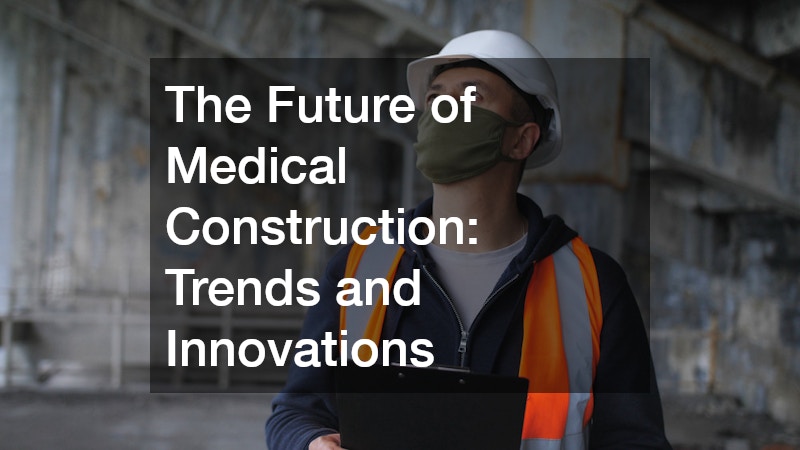The landscape of medical construction is rapidly evolving, driven by technological advancements and an increased focus on patient-centric care. As healthcare systems worldwide strive to meet the growing demand for efficient services, the architecture and construction of medical facilities have become pivotal. Understanding the current trends and future innovations in medical is essential for stakeholders aiming to build sustainable and adaptable healthcare environments.
With evolving patient needs and the integration of new technologies, construction on medical spaces is at a transformative crossroads. Concepts such as smart buildings, eco-friendly materials, and modular designs are not just futuristic ideas but present-day realities reshaping the medical industry. This article delves into the various trends and innovations anticipated to define the future of medical, providing insights into how they will revolutionize healthcare infrastructure.
The integration of advanced technology, attention to sustainability, and flexible design principles are integral to modern construction strategies. These elements not only enhance the functionality and efficiency of healthcare facilities but also ensure they are equipped to handle future challenges. As such, diving deeper into these trends offers a comprehensive view of what to expect in the coming years.
Technological Advancements
Technological progress is at the heart of transformations within the construction field. Incorporation of digital tools such as Building Information Modeling (BIM) allows for more precise planning and collaboration among architects, engineers, and contractors. BIM reduces errors and omissions by allowing detailed visualization and simulation of construction projects before ground is even broken.
The adoption of smart technology in medicine is making facilities more efficient and adaptable. Smart buildings equipped with IoT (Internet of Things) devices can monitor various aspects of the hospital environment, optimizing energy use, enhancing security, and improving patient comfort. Furthermore, telemedicine rooms designed into facilities enable remote consultations, broadening healthcare access.
Robotics and automation in medical construction are paving the way for faster and safer construction processes. Robots can undertake repetitive tasks with precision, reducing labor costs and minimizing human error. Automation extends to systems such as HVAC and lighting, which are being programmed to adapt automatically to changes in usage patterns to conserve resources.
Sustainability Initiatives in Healthcare Construction
With environmental concerns at an all-time high, sustainability is becoming a standard rather than a luxury in construction. Utilizing eco-friendly materials and renewable energy sources significantly reduces the carbon footprint of healthcare facilities. Architects and builders are prioritizing green building certifications, such as LEED, to ensure that new medical centers meet stringent environmental criteria.
The design of healthcare facilities increasingly includes features that reduce energy consumption and waste. For instance, the integration of energy-efficient lighting, on-site renewable energy production, and rainwater harvesting systems are becoming the norm. These sustainable practices not only benefit the environment but also contribute to lower operational costs over time.
Sustainable construction incorporates the principle of resiliency, preparing buildings to withstand natural disasters and climate change impacts. By focusing on durability and resource efficiency, construction can support healthcare delivery that is uninterrupted by environmental challenges. This commitment to sustainability ensures facilities are safeguarded against future uncertainties.
Modular and Flexible Building Designs
The demand for rapid deployment and flexible use of medical spaces is leading to a rise in modular construction techniques. Prefabricated modules allow for quicker assembly and can be easily reconfigured or expanded to accommodate changing needs. This agility is particularly advantageous in emergency situations, where hospitals need to increase capacity swiftly.
Modular designs cater to the diverse functionalities required within a healthcare setting, enabling efficient use of space. By allowing parts of a facility to be repurposed with minimal disruption, hospitals can adapt to new medical technologies and procedures. Flexibility in building design is critical for maintaining relevance amidst the fast pace of medical innovation.
Designing with future growth in mind, construction increasingly focuses on flexibility within traditional structures. Features such as movable partitions and convertible spaces ensure areas can be adapted for multiple uses over time. This level of flexibility not only enhances the practical utility of healthcare facilities but also improves patient care by reacting to evolving service demand without requiring new construction.
The future of medical construction is being shaped by a multitude of trends and innovations aimed at enhancing healthcare delivery and facility efficiency. Technological advancements are enabling smarter, faster, and safer construction processes, while sustainability initiatives ensure the minimization of environmental impact. Flexible construction methods provide healthcare facilities with the capacity to adjust to future needs seamlessly.
As medical construction evolves, collaboration among industry stakeholders, including architects, healthcare providers, and policymakers, is crucial to realizing these advancements. Embracing these trends ensures the creation of healthcare environments that are not only state-of-the-art but also equipped to meet future challenges. Ultimately, the success of construction initiatives depends on their ability to balance technology integration, sustainability, and flexibility.
These progressive approaches to construction will revolutionize healthcare infrastructure, making it more resilient, efficient, and responsive to global health demands. By keeping abreast of these trends, developers and healthcare providers can ensure that they are building facilities that will cater to the needs of future generations effectively. Medical construction, when leveraged correctly, holds the potential to significantly improve both the quality and accessibility of healthcare services worldwide.


